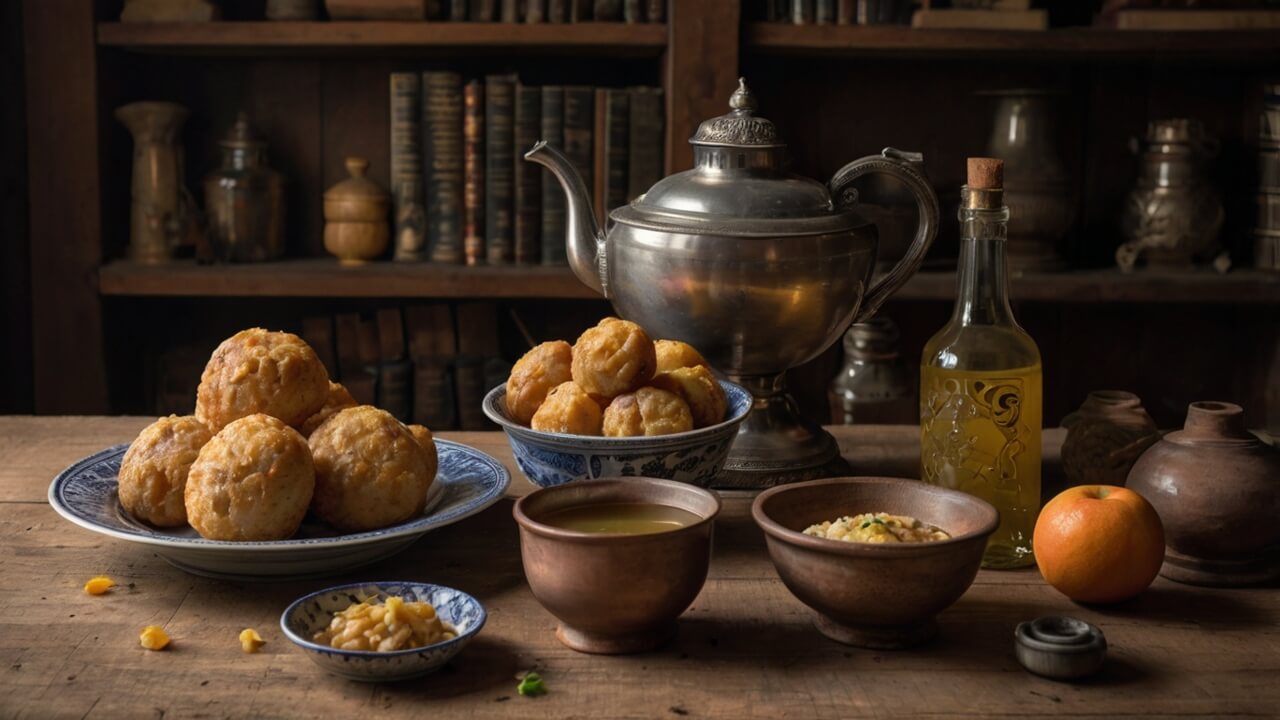The 17th century marked a pivotal era in the evolution of culinary traditions, where cooking methods and ingredients underwent significant transformations.
This period witnessed the emergence of new flavors, techniques, and culinary influences that continue to shape our modern dining experiences.
Exploring the recipes of the 17th century offers a captivating glimpse into the rich tapestry of food culture from that time.
These historical dishes not only showcase the ingenuity and resourcefulness of our ancestors but also serve as a testament to the enduring human desire to experiment, innovate, and savor the diverse flavors of the world.
Beyond mere sustenance, food has always been a reflection of societal values, cultural exchange, and the creative expression of generations past.
By delving into the culinary practices of the 17th century, we gain a deeper appreciation for the intricate connections between food, history, and the human experience.
Preserving and reviving these historical recipes is not merely an exercise in nostalgia; it is a celebration of our culinary heritage and a recognition of the profound impact that food has on shaping our identities and traditions.
Through the recreation of these dishes, we forge a tangible link to our ancestors, honoring their culinary wisdom while adapting it to the modern palate.
Authentic 17th Century Dessert Recipes

Desserts in the 17th century were a delightful blend of flavors, often incorporating fruits, nuts, and spices. These sweet treats were not only indulgent but also a reflection of the era’s culinary ingenuity and resourcefulness.
Jumbals
Description: Jumbals, also known as “jumbles” or “gemmels,” were a popular 17th-century cookie or sweet biscuit. These ring-shaped treats were made with a simple dough flavored with rosewater, aniseed, and currants.
Original Recipe:
“Take a peck of fine flowre, and a pound of butter, a pound of sugar, a little rose-water, an ounce of aniseeds, a little salt, and as much cream as will make it into a very thick batter; then, with a little fire under them, fry them as you do pancakes, only let your batter be thicker.”
Modern Adaptation: To make jumbals today, you can use a basic cookie dough recipe and add rosewater, aniseed, and currants. Roll the dough into rings or twists before baking for an authentic look and texture.
Cake with Almonds
Description: This rich and decadent cake was a favorite among the upper classes. Featuring almonds as a prominent ingredient, it was often flavored with rosewater and decorated with sugar or candied fruits.
Original Recipe:
“Take a pound of sweet Almonds, blanch’d and beaten, a pound of loaf Sugar, a pound of Butter, ten Eggs, leaving out half the Whites, a little Rose-water, and a little Salt; beat all these very well together, and bake it in a quick Oven.”
Modern Adaptation: To recreate this cake, you can use a modern almond cake recipe and incorporate rosewater for a subtle floral aroma. Garnish with sliced almonds or candied fruits for an authentic touch.
Syllabub
Description: Syllabub was a popular 17th-century dessert that combined cream, sweetened wine or cider, and spices. It was often served in a glass or dish and enjoyed as a refreshing treat.
Original Recipe:
“Take a quart of thick Cream, and half a pint of Sack, the juice of two Seville Oranges or Lemons, grate in the rind of two Lemons, sweeten the Cream and Wine with Sugar to your taste, then whip it altogether with a whisk, and remove it with a Spoon as it rises and piles up.”
Modern Adaptation: To make syllabub today, you can whip heavy cream and fold in sweetened wine or cider, along with freshly grated citrus zest and juice. Serve chilled in glasses or dishes for a refreshing and indulgent dessert.
Fruit Puffs
Description: Fruit puffs were light and airy pastries filled with a variety of fruit fillings, such as apples, cherries, or currants. They were often dusted with sugar and served as a delightful sweet treat.
Original Recipe:
“Take a pint of flour, half a pint of cream, six eggs, a little salt, and as much butter as will make it into a paste; then roll it out very thin, and spread on it what fruit you please, and close it up like an apple-puff, and bake it.”
Modern Adaptation: To make fruit puffs, prepare a basic puff pastry dough and roll it out thin. Fill with your desired fruit filling, such as apple or cherry compote, and seal the pastry. Bake until golden brown and dust with powdered sugar for a delightful treat.
These authentic 17th-century dessert recipes offer a delightful glimpse into the era’s culinary delights. By recreating them in modern kitchens, you can savor the flavors of the past while appreciating the ingenuity of historical cooks.
Savory 17th Century Dishes
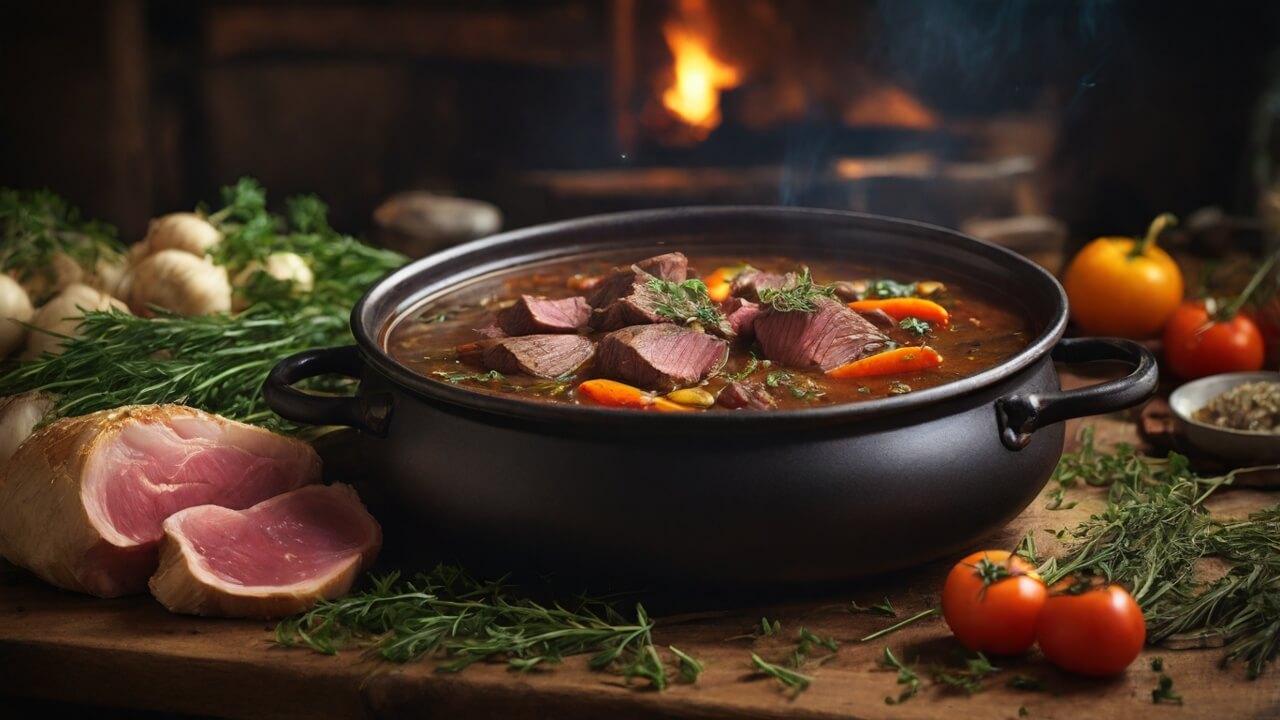
The 17th century was a time when savory dishes were not only a culinary delight but also a reflection of the cultural and agricultural traditions of the era. From hearty oat-based fare to ingenious methods of pickling and preserving, the savory recipes of this period offer a fascinating glimpse into the resourcefulness and creativity of our culinary ancestors.
Oat Cakes and Oatmeal Pancakes
Oats were a staple ingredient in 17th-century Britain, and they found their way into a variety of dishes, both sweet and savory. Oat cakes, also known as “bannocks,” were a simple yet satisfying bread made from oats, salt, and water. These dense, unleavened flatbreads were cooked on a griddle or bakestone and often served as a accompaniment to soups, stews, or as a portable snack for travelers.
The original recipe for oat cakes called for grinding oats into a coarse meal, mixing it with salt and hot water, and kneading the dough until it formed a smooth ball. The dough was then rolled out into thin rounds and cooked on a hot surface until lightly browned on both sides.
In a modern adaptation, oat cakes can be made with a combination of rolled oats, whole wheat flour, and a touch of butter or oil for added richness. They can be served warm, topped with savory spreads like cheese or smoked fish, or even used as a base for miniature open-faced sandwiches.
Oatmeal pancakes, another beloved dish, were a heartier version of the modern pancake, made with a batter of oats, buttermilk or ale, eggs, and a leavening agent like baking soda or potash. These substantial pancakes were often served with savory toppings like smoked meat or cheese, providing a filling and nourishing start to the day.
Pickled Onions and Cherries
In an era before modern refrigeration, pickling was an essential technique for preserving and extending the shelf life of fruits and vegetables. Pickled onions, in particular, were a beloved condiment, often served alongside roasted meats or as a tangy addition to salads and sandwiches.
The original recipe called for peeling and slicing onions, layering them with salt in a crock or jar, and covering them with a vinegar solution infused with spices like mustard seed, black pepper, and bay leaves. The onions would then be left to pickle for several weeks, allowing the flavors to meld and the vinegar to penetrate the layers.
In modern times, pickled onions can be made with a variety of vinegars, such as apple cider or red wine vinegar, and customized with different spice blends to suit individual tastes. They make a delightful accompaniment to charcuterie boards, burgers, or as a zingy topping for tacos or sandwiches.
Pickled cherries, though lesser known today, were also a popular treat in the 17th century. Ripe cherries were carefully packed into jars or crocks, covered with a vinegar solution infused with sugar, spices like cinnamon and cloves, and sometimes a touch of brandy or wine. The cherries would then be left to pickle, resulting in a sweet-and-sour delight that could be enjoyed as a dessert or used to garnish savory dishes.
Mini Chicken and Bacon Pies
Portable and satisfying, these miniature meat pies were a beloved snack or meal for travelers and workers alike. The original recipe called for a savory filling of minced chicken or other poultry, bacon or salt pork, and a blend of herbs and spices like thyme, parsley, and black pepper. This mixture was then encased in a sturdy pastry crust made from flour, butter or lard, and water.
The individual pies were baked until the crust was golden brown and the filling was piping hot, creating a portable and nourishing meal that could be easily carried and enjoyed on the go.
In a modern adaptation, these mini pies can be made with a variety of fillings, such as chicken and mushrooms, beef and vegetables, or even vegetarian options like lentils and cheese. The pastry crust can be made with butter or oil for a flakier texture, and additional herbs and spices can be incorporated to suit contemporary tastes.
Posset Pie
A unique and decadent creation, the posset pie combined the richness of a creamy posset (a hot, curdled milk-based dessert) with the savory flavors of meat and spices. The original recipe called for a filling made by curdling cream or milk with wine or ale, then mixing it with minced meat, such as chicken or veal, eggs, and a blend of spices like cinnamon, nutmeg, and ginger.
This mixture was then poured into a pastry crust and baked until set, resulting in a custard-like filling with a savory twist. The contrast between the creamy, sweet posset and the savory meat and spices made for a truly unique and indulgent dish.
In a modern adaptation, the posset pie can be made with a variety of dairy alternatives, such as coconut milk or almond milk, and the meat can be substituted with plant-based proteins or omitted entirely for a vegetarian version. The spice blend can also be adjusted to suit contemporary tastes, with the addition of flavors like cardamom or saffron for a more exotic twist.
These savory 17th-century dishes not only tantalize the taste buds but also offer a fascinating glimpse into the culinary ingenuity and resourcefulness of our ancestors. By exploring and adapting these historic recipes, we can appreciate the rich tapestry of culinary traditions that have shaped our modern dining experiences.
Historic Breads and Toasts
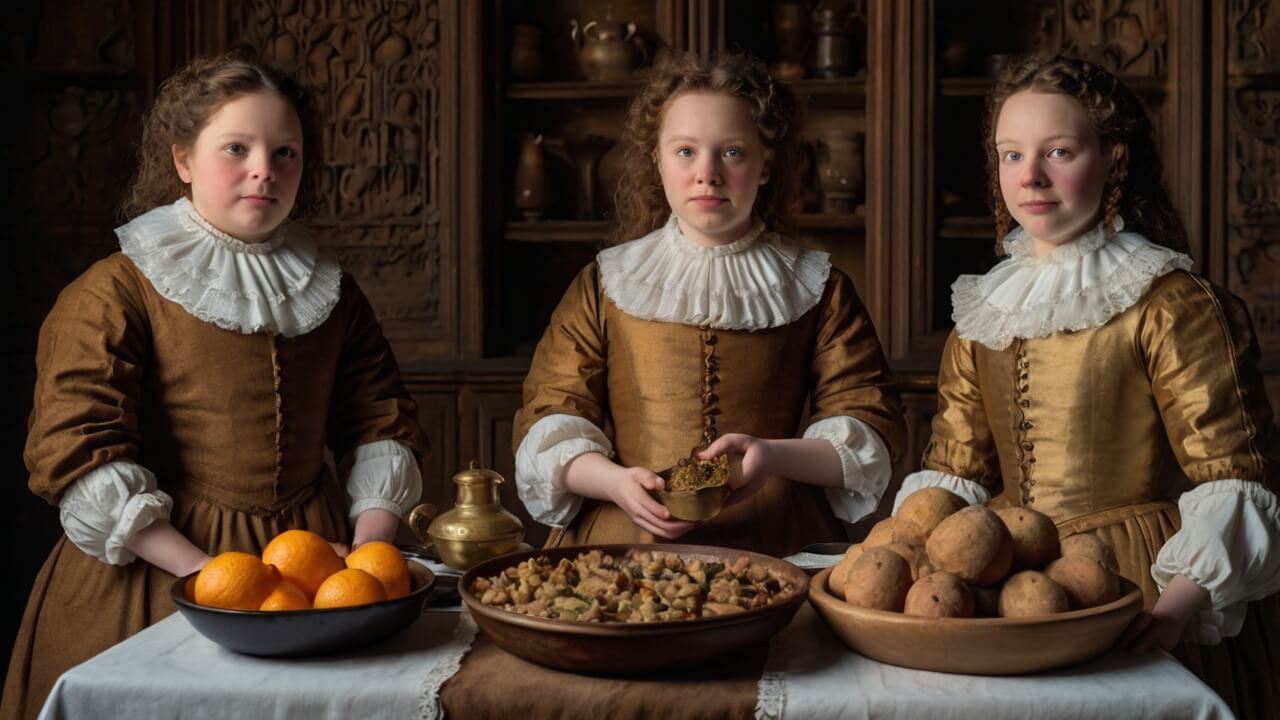
The 17th century was a time when bread was a staple food, consumed at every meal. Beyond basic loaves, however, cooks of the era experimented with various bread-based dishes, including savory toasts and griddle breads. Two notable examples are French Tosts and Cheese and Onion Toast.
French Tosts were a popular breakfast or snack item, consisting of slices of bread dipped in a mixture of cream, eggs, and spices, and then fried in butter or oil. The original recipe called for thick slices of stale bread, soaked in a batter made with cream, eggs, sugar, and rosewater or cinnamon. The soaked bread was then fried until golden brown and crispy on the outside, while remaining soft and custard-like on the inside.
To adapt this recipe for modern kitchens, you can use day-old bread or brioche, and substitute the cream with milk or plant-based alternatives. The eggs can be whisked with a splash of vanilla extract, cinnamon, and a pinch of nutmeg. Fry the soaked bread slices in a mixture of butter and oil until golden brown on both sides, and serve warm with a drizzle of honey or maple syrup.
Cheese and Onion Toast was a savory treat, often enjoyed as a light meal or accompaniment to drinks. The original recipe involved toasting thick slices of bread, then layering them with a mixture of grated cheese, finely chopped onions, and butter. The toasts were then returned to the oven or placed under a hot grill until the cheese melted and the onions softened.
To recreate this dish today, you can use a hearty bread like sourdough or a rustic country loaf. Grate a flavorful cheese like cheddar or gruyere, and sauté finely sliced onions in butter until translucent and slightly caramelized. Layer the cheese and onions generously on the toasted bread slices, and broil or bake until the cheese is melted and bubbling. Sprinkle with fresh herbs like thyme or chives for an added depth of flavor.
Both French Tosts and Cheese and Onion Toast offer a delightful glimpse into the culinary ingenuity of the 17th century, while also providing straightforward adaptations for modern palates and kitchens.
Ingredients of the Era
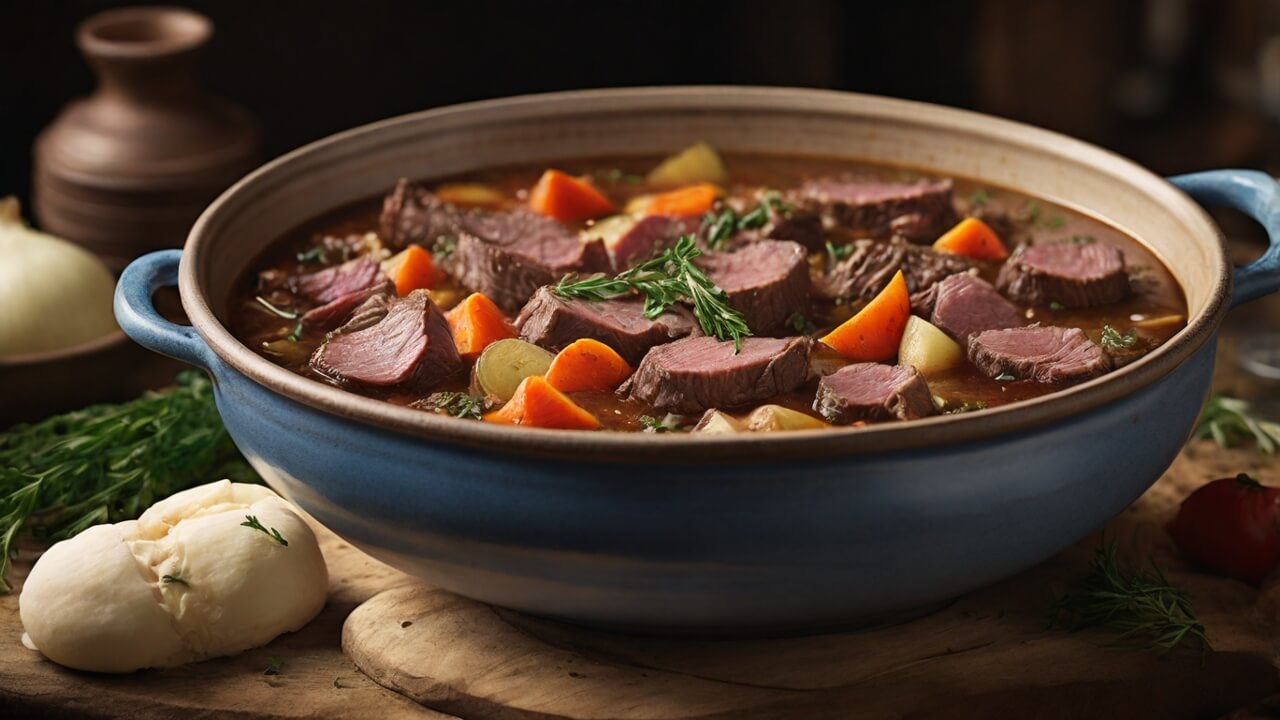
The 17th century was a time of culinary exploration, as new ingredients and spices from far-flung lands made their way into European kitchens. Common staples included grains like wheat, rye, and oats, as well as vegetables such as onions, carrots, and cabbages. Meats like beef, pork, and poultry were widely consumed, often preserved through salting or smoking.
Preparation methods of the time were labor-intensive, with ingredients often being ground or pounded by hand using mortars and pestles. Grains were milled into flour, and butter was churned by hand from cream. Fruits and vegetables were typically preserved through drying, pickling, or candying, ensuring their availability year-round.
Spices played a crucial role in 17th-century cuisine, adding depth of flavor and often serving as a symbol of wealth and status. Cinnamon, nutmeg, cloves, and mace were highly prized and used liberally in both sweet and savory dishes. These exotic spices, along with sugar, were imported from the East and West Indies, fueling a burgeoning global trade.
Imported goods like citrus fruits, olives, and olive oil also found their way into European kitchens, introducing new flavors and techniques. The influx of these ingredients from distant lands not only transformed culinary traditions but also reflected the expanding horizons of the era.
Cooking Techniques and Tools
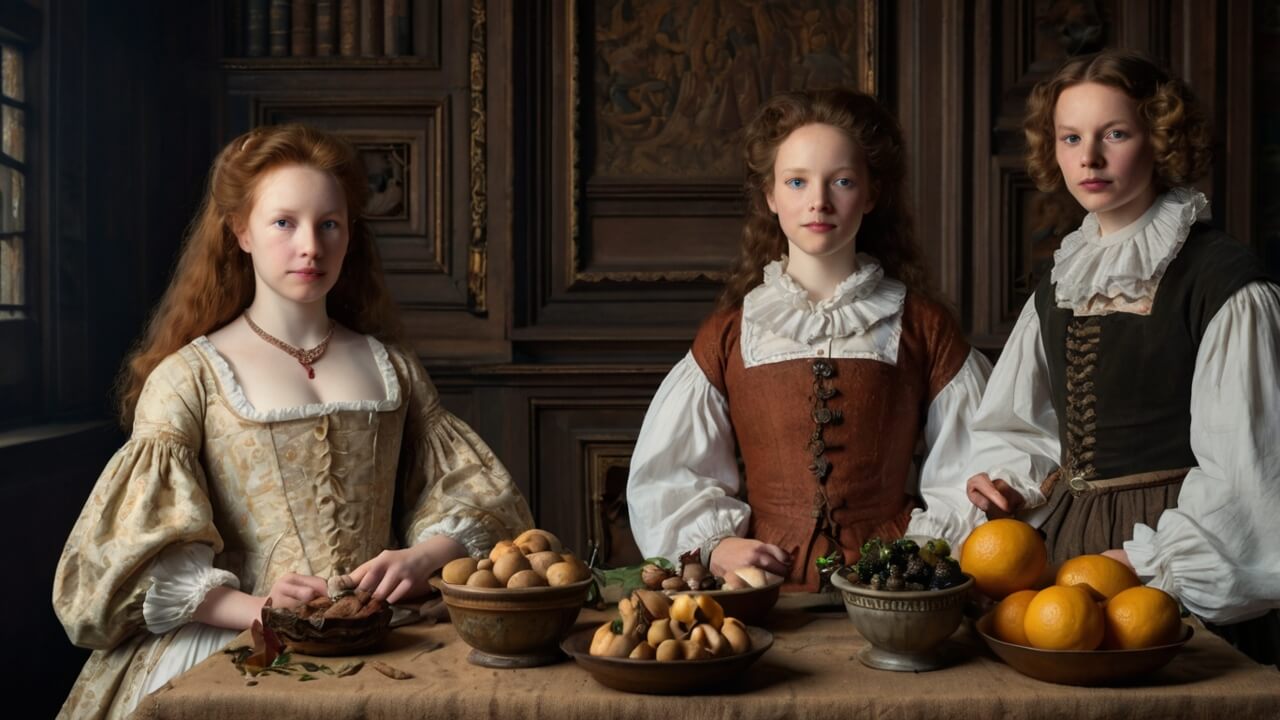
In the 17th century, cooking was a laborious and time-consuming process, often relying on rudimentary techniques and tools. The primary cooking method was over an open hearth or in a brick oven, which required constant tending and fuel replenishment.
Common cooking techniques included:
- Roasting: Meats and larger cuts were often roasted on a spit or hung in front of the fire, requiring frequent basting and turning to ensure even cooking.
- Boiling: Liquids, grains, and vegetables were frequently boiled in large cauldrons or pots suspended over the fire. This technique was also used for preserving fruits and meats.
- Baking: Breads, pies, and pastries were baked in brick ovens or portable tin ovens heated by hot coals. Temperature regulation was challenging, often resulting in unevenly baked goods.
- Frying: Meats, vegetables, and fritters were fried in rendered animal fats or oils in cast iron skillets or shallow pans over the hearth.
The common cooking utensils and equipment of the era included:
- Cauldrons and Pots: Large, heavy pots made of cast iron or copper were essential for boiling, stewing, and preserving foods.
- Spits and Turnbroche: Long, rotating metal rods were used for roasting meats over the open fire. A turnbroche, a dog-powered spit turner, was often employed to keep the spit rotating.
- Brick Ovens: Built into the hearth, these ovens were heated by burning wood or coal, providing radiant heat for baking breads, pies, and other baked goods.
- Kettles: Copper or iron kettles were used for heating water, making broths, and cooking smaller portions of food.
- Mortar and Pestle: These tools were crucial for grinding spices, herbs, and other ingredients into powders or pastes.
- Baking Tins and Molds: Primitive versions of modern bakeware, such as pie tins and molds, were used for shaping and baking pastries and breads.
While rudimentary by today’s standards, these cooking techniques and tools were essential to the culinary practices of the 17th century, shaping the flavors and textures of the era’s cuisine.
Modernizing Historic Recipes
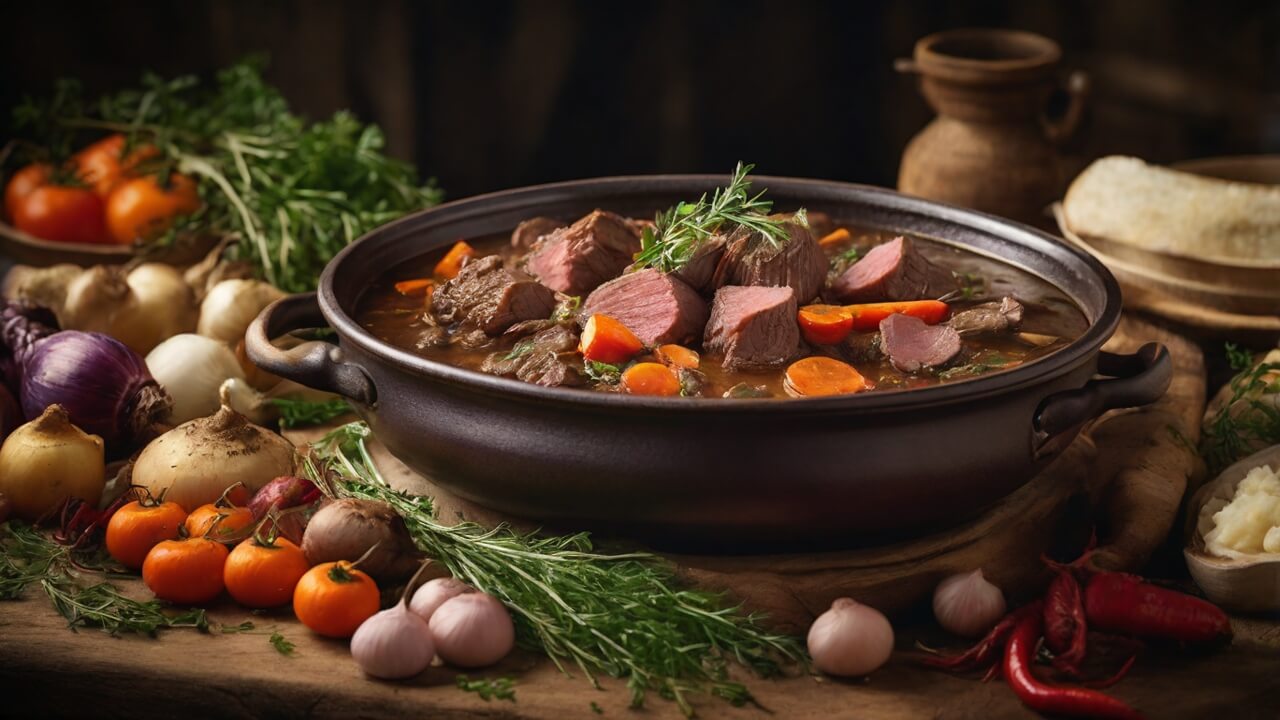
Recreating 17th-century recipes in modern kitchens can be a delightful culinary adventure, but it requires some adaptations and creativity. Here are some tips to help you successfully modernize these historic gems:
Adapting Recipes:
- Adjust measurements to fit modern standards (e.g., convert pinches to teaspoons).
- Substitute hard-to-find ingredients with readily available alternatives while maintaining the essence of the dish.
- Modify cooking times and temperatures to suit contemporary kitchen equipment.
- Simplify complex techniques or break them down into more manageable steps.
Sourcing Authentic Ingredients:
- Explore local farmers’ markets or specialty stores for heirloom varieties of fruits, vegetables, and herbs.
- Use traditional fats like lard, tallow, or clarified butter for an authentic flavor.
- Seek out spice purveyors or ethnic markets for hard-to-find spices and seasonings.
- Grow your own herbs or search for heritage seeds to cultivate historic varieties.
Equipment Substitutions:
- Use a Dutch oven or heavy-bottomed pot as a substitute for a cast-iron cauldron.
- Replace a brick oven with a conventional oven, adjusting temperatures as needed.
- Utilize a food processor or blender for tasks that would have required extensive manual labor.
- Employ a modern whisk or handheld mixer for whipping and aeration instead of a roux whisk or bundle of twigs.
With a little creativity and resourcefulness, you can bring the flavors and techniques of the 17th century into your modern kitchen, preserving culinary heritage while adapting to contemporary tastes and conveniences.
Host a 17th Century Dinner
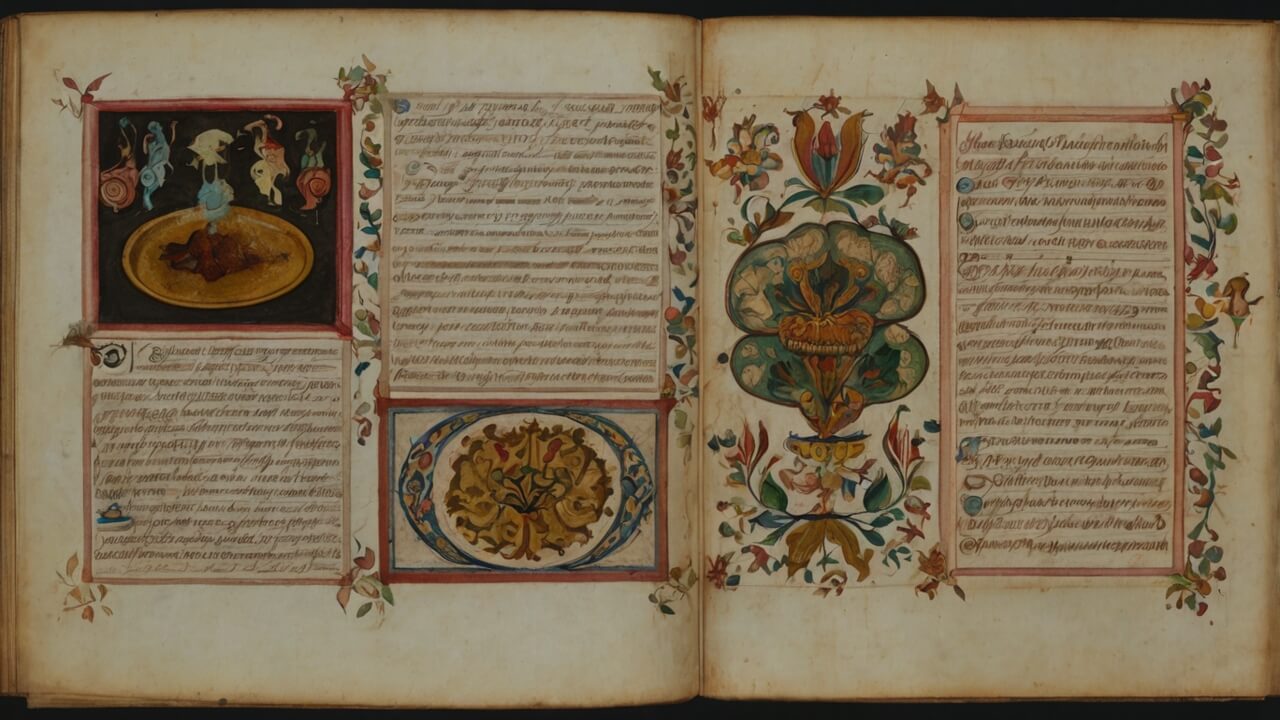
For those seeking an immersive culinary experience, hosting a 17th-century themed dinner party is an excellent way to transport your guests back in time. This era offers a wealth of culinary delights and traditions that can be incorporated into a memorable evening.
To set the stage, consider decorating your dining area with elements reminiscent of the 17th century. Use candlelight, pewter or wooden dishware, and linen napkins to create an authentic ambiance. You could even encourage your guests to dress in period attire, adding to the overall atmosphere.
When it comes to the menu, start with a selection of appetizers inspired by the era. Pickled vegetables, such as onions or cherries, were popular at the time and make for an intriguing start to the meal. Alternatively, you could serve a savory pie or tart, like the mini chicken and bacon pies featured in this article.
For the main course, consider hearty dishes like roasted meats or stews, accompanied by traditional sides like oat cakes or bread trenchers. These dishes not only showcase the flavors of the era but also highlight the use of locally sourced ingredients, which was common practice in the 17th century.
No 17th-century feast would be complete without a selection of decadent desserts. Impress your guests with treats like jumbals (a type of cookie), syllabub (a creamy, wine-based dessert), or fruit puffs. These sweet indulgences were popular among the upper classes and will undoubtedly delight modern palates as well.
To complement the meal, consider serving traditional beverages like mead, ale, or mulled wine. These drinks were enjoyed by people of all social classes during the 17th century and will add an authentic touch to your dining experience.
Finally, don’t forget to set the table with care. Use linens, pewter, or wooden tableware to recreate the ambiance of the era. You could even incorporate elements like herbs or flowers as centerpieces, which were common table decorations in the 17th century.
By embracing the culinary traditions of the 17th century, you can transport your guests to a different era and create a truly memorable dining experience. With a well-planned menu, authentic decor, and a touch of historical flair, your 17th-century dinner party is sure to be a resounding success.
Preserving Culinary Heritage
Preserving historical recipes is more than just a culinary endeavor; it is a way to honor our cultural heritage and keep the traditions of our ancestors alive. Food has always been a fundamental part of human society, reflecting the values, beliefs, and way of life of a particular era. By recreating and savoring these time-honored dishes, we can gain a deeper appreciation for the ingenuity and resourcefulness of past generations.
Recipes are not merely a collection of ingredients and instructions; they are a testament to the resilience and creativity of our forebears. Each recipe tells a story, woven with the threads of history, culture, and personal experiences. From the humble oatcakes that sustained families during times of scarcity to the decadent syllabubs that graced the tables of nobility, these recipes offer a glimpse into the lives of those who came before us.
Furthermore, preserving culinary heritage is a way to foster intergenerational connections. By sharing these recipes with younger generations, we can instill in them a sense of pride and appreciation for their roots. Cooking together becomes a bonding experience, where stories are shared, and traditions are passed down like cherished heirlooms.
In a world that is constantly evolving, it is essential to hold on to the threads that connect us to our past. By embracing and celebrating historical recipes, we not only honor our ancestors but also ensure that their legacies live on, inspiring future generations to explore and appreciate the rich tapestry of culinary traditions.
Conclusion
The culinary world of the 17th century offers a fascinating glimpse into the rich tapestry of history, where recipes were not just a collection of ingredients but a reflection of cultural traditions, social norms, and the ingenuity of our ancestors.
Preserving these historic recipes is more than a mere exercise in nostalgia; it’s a way to honor the legacy of those who came before us and to appreciate the evolution of our modern culinary landscape.
As you’ve explored the authentic recipes and cooking techniques of the 17th century, you’ve likely developed a newfound respect for the skill and resourcefulness of the era’s cooks. From the intricate jumbals to the comforting oat cakes, each dish tells a story of resilience, creativity, and a deep connection to the land and its bounty.
We encourage you to step into the shoes of a 17th-century chef and try your hand at recreating these historic recipes. Whether you’re hosting a themed dinner party or simply indulging in a taste of the past, the experience of preparing and savoring these dishes will transport you to a time when cooking was not just a necessity but an art form.
Share your culinary adventures on social media, using the hashtag #17thCenturyCuisine, and inspire others to explore the rich tapestry of culinary history. And don’t forget to subscribe to our newsletter, where we’ll continue to unveil the secrets of historic recipes and provide tips for adapting them to modern kitchens.
By preserving and celebrating the culinary heritage of the 17th century, we not only honor our ancestors but also enrich our own lives with the flavors, techniques, and stories that have withstood the test of time.

